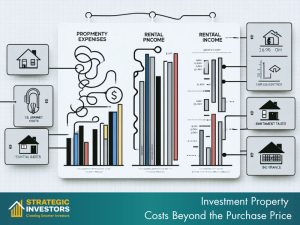
Are you ready to venture into the world of property investment but unsure of “how much can I borrow investment property” to make your dream a reality?
In this comprehensive guide, we will walk you through the essential steps to maximize your loan for investment property while minimizing risks.
From assessing your borrowing capacity and understanding lender’s criteria to leveraging equity and navigating tax implications, we have you covered.
Key Takeaways
- Understand borrowing capacity and lender criteria for investment property loans.
- Consider deposit size, additional costs, rental income & vacancy rates when budgeting.
- Utilize equity & guarantors to increase borrowing capacity. Prepare documents for loan application process.
Determining Your Borrowing Capacity for Investment Property

Assessing Income and Expenses
In order to work out your borrowing potential, it is important to examine both incoming sources of money like salary, commission, rewards and rental income as well as the costs associated with owning a property such as loan payments, upkeep fees for managing the asset in question plus insurance expenses. You should be able to cover any outlays during times when there are no tenants. To calculate if these financials will last over time and Make ownership of an investment property feasible or not, one must carefully review their profits against expenditures incurred.
Understanding Lender’s Criteria
When applying for an investment property loan, lenders evaluate multiple criteria. These include the borrower’s ability to repay, credit score history, Loan-to-Value ratio (LVR), and any rental income potential from the target property.
Having a good credit record can bolster borrowing capacity while those with adverse histories might be restricted or faced with higher interest rates on loans approved. Knowing what specific requirements banks ask when vetting applications will help applicants better prepare themselves, which could increase their chances of securing such finance solutions for real estate investments.
Importance of a Solid Financial Foundation
Prior to purchasing an investment property, you need a strong financial foundation. To achieve this goal, there are many preparatory steps needed such as defining your aims and evaluating risk tolerance. Mastering cash flow management and analyzing the potential return of any given property is essential for success in real estate investing. Having good credit can allow borrowers more appealing loan options that may better meet their needs when buying investments properties with larger sums required than other types of purchases do.
In terms of priorities related to attaining these objectives. Proper budgeting plus developing a robust strategy should be near the top followed by understanding current market values applicable to particular investments desired or at least similar assets from which usable comparisons might be made. Finally, key aspects like managing personal finances effectively while accruing equity will prove necessary if pursuing favorable results in one’s investment endeavors involving another piece of residential or commercial real estate is truly wanted.
The Role of Deposit in Loan Amounts

Knowing what kind of investments are available to you through varying levels of depositing is essential for ensuring successful outcomes with real estate investing. A bigger initial lay-out when purchasing an investment property could pay off greatly over time by bringing down both the amount borrowed and the interest incurred.
Minimum Deposit Considerations
When it comes to investment property loans in Australia, the usual minimum deposit required is 20% of the purchase price. Though some lenders may accept a lower payment with certain requirements (e.g., LMI), there are risks involved such as more costly borrowing and limited options for properties. While putting down larger deposits can lead to better loan terms and reduced interest rates, one must consider all potential issues before making their decision.
The Impact of Lenders Mortgage Insurance (LMI)
A type of insurance policy, known as Lenders Mortgage Insurance (LMI), is in place to protect lenders from borrowers who fail to make their loan repayments. If you are required by your lender and the given situation calls for it, this means that a higher deposit than 20% of the property value may be necessary – which would consequently increase borrowing costs due to paying premiums on the LMI coverage. The amount charged depends upon several factors such as what kind of loan has been taken out with specific providers or banks along with its corresponding borrowed sum.
Strategies to Increase Your Deposit
If you are looking to increase your deposit for an investment property, using the equity from current properties is a good option. This allows access to larger loan amounts without needing large deposits upfront – and can reduce or remove the requirement of LMI (Loan Mortgage Insurance). Having a guarantor that provides additional security on loans may help unlock even higher loan sizes.
Investment Property Costs Beyond the Purchase Price

Planning for Ongoing Costs
For an investment property, it is important to consider the ongoing expenses that come with owning a loan. This may include things such as repayments of said loan, insurance premiums and taxes owed on the real estate in question. It’s recommended to account for 0.40-0.75% of your property’s value each year towards upkeep. Likewise, management fees can often range between 5-15%, tending more toward 7.5%. When thinking about budgeting related specifically to this type of asset ownership, one must factor all these costs into consideration beforehand, otherwise there could be unforseen financial burdens later down the line!
Factoring in Vacancy Rates and Rental Income
To measure the financial health of your investment property, pay attention to both vacancy rate and rental income. Calculate vacancies by dividing empty units among all total units multiplied by 100. Locations, economic forces as well as supply/demand dynamics will influence rates. Estimating rental revenue can be done by multiplying weekly or monthly rent with number of weeks in a year then divide it from what was paid for that specific real estate acquisition. Assessing profitability necessitates considering these factors too!
Choosing the Right Investment Loan

Comparing Loan Terms and Repayment Structures
When evaluating investment loans, look at factors like interest rates and loan terms to determine the best solution for your property. For instance, usually shorter duration investments are granted lower interest rates. With longer term ones since lenders consider them less risky.
The primary types of repayment structures available for such kind of borrowing include offset accounts, principal plus interests or just simple interests only plans, analyze their pros and cons before picking a suitable one for you.
Benefits of Offset Accounts and Additional Repayments
Having an offset account linked to your loan balance can save you money on interest payments and potentially reduce the repayment term of your investment property. By making additional home loan repayments or mortgage contributions towards the principal amount, it could fasten up the entire process significantly. This method would also contribute to a decrease in overall financial expenditure for borrowing against said property as well as shorten its duration.
Leveraging Equity and Guarantor Loans

Use the available equity from pre-owned properties or have someone guarantee the security of your investment property loan.
Utilizing Usable Equity from Existing Properties
By taking advantage of the available equity in your current properties, you may be able to raise up to 80% of a property’s value as a deposit for an investment. This can provide potential benefits such as expanding borrowing capacity and access to funds, along with tax advantages from diversifying investments. There is always associated risk when using home-equity loans, if they are not repaid back it could lead into foreclosure proceedings. It’s important then that careful considerations are made before tapping this resource.
The Advantages of Having a Guarantor
A family member’s equity in their property can be used to secure a loan for an investment without requiring the borrower to have a substantial deposit. This is known as guarantor loans and allows them to reduce or eliminate LMI. Having someone guarantee your loan could provide additional funds towards its repayment.
It should be noted that being a guarantor includes risks such as legal fees and responsibilities related with securing the investment property loan, of which they need full understanding before making any decision on it.
Tax Implications and Incentives

Navigating Tax Deductible Expenses
If you have an investment property, take advantage of tax deductions for expenses incurred. This includes things like mortgage interest payments, management and legal fees to name a few. Repairs or maintenance charges that may be necessary can also help reduce your taxable amount when it comes time to file taxes each year. Don’t forget about the benefits associated with depreciation as well! Speak with a qualified tax specialist in order to optimize these advantages towards rental properties under your ownership before filing returns annually.
Understanding Capital Growth and Tax Benefits
When it comes to investment properties, capital growth or the increase in a property’s value over time can have a major impact on its profitability. To make sure you benefit from this potential gain, it is important to be aware of applicable tax incentives and exemptions related to property values and prices. This will allow for wise decisions that could maximize your return on investment.
Negative gearing as well as capital gains tax exemptions are two factors which must always be kept in mind when trying to optimize earnings through real estate investments.
Preparing for the Application Process

Documentation Checklist
Before submitting your loan application, collect the required documentation to support it. This should include identification documents as well as evidence of income and assets, statements from banks, credit history reports with good ratings. To details on the property you own: position, type, value plus any current leases or rental agreements that may be generating an income for you.
Tips for a Smooth Approval Process
When aiming for a smooth approval process in getting an investment property loan, following these tips can be beneficial. Firstly, having and maintaining a good credit score is essential. Ensuring all the information provided is correct must also occur. Seeking professional advice when needed could boost your chances of securing such a loan. The more favorable your credit history appears as well as achieving low debt-to-income ratio may increase borrowing capacity opportunities, on the other hand poor credit ratings have been known to lead to rejection or less favourable terms when it comes to loans related to properties.
By heeding this useful info you are increasing your chances of obtaining an investment property, which makes buying one much easier than initially thought!
Summary
Having the right knowledge is key to succeeding in investing in property, and this includes understanding your borrowing power, utilizing equity loans or guarantor finance options that consider long-term costs as well as tax responsibilities. You need to be prepared for loan application procedures. With these tips under consideration, it will help get you started on a successful journey of purchasing an investment property.
Frequently Asked Questions

What is the maximum loan for an investment property?
When buying an investment property, loan lenders may allow up to 90-95% of the value as a loan and this includes LMI insurance. You can apply for a sizeable amount in order to purchase your desired property.
Can I buy an investment property with 30k?
Given the Loan to Value Ratio (LVR) of 80%, it is unlikely that a deposit of $30,000 will suffice for purchasing an investment property. Although not optimal, you may be able to purchase such a property but with potentially costly Lenders Mortgage Insurance (LMI).
How much can I borrow on 120k salary?
As long as your mortgage payments remain comfortable and manageable, it is estimated that with a salary of $120,000 you can take on up to 4.5 times this amount – or $540,000 – for a loan.
How much do you need to earn to borrow 500k?
In order to borrow $500,000, you must have an annual salary of at least 180K. This would require regular interest and principal payments every month with a substantial amount of total interest owed throughout the repayment period.
What factors should I consider when determining my borrowing capacity for an investment property?
When determining my borrowing capacity for an investment property, I should consider assessing my income and expenses, understanding the lender’s criteria, and building a solid financial foundation.













